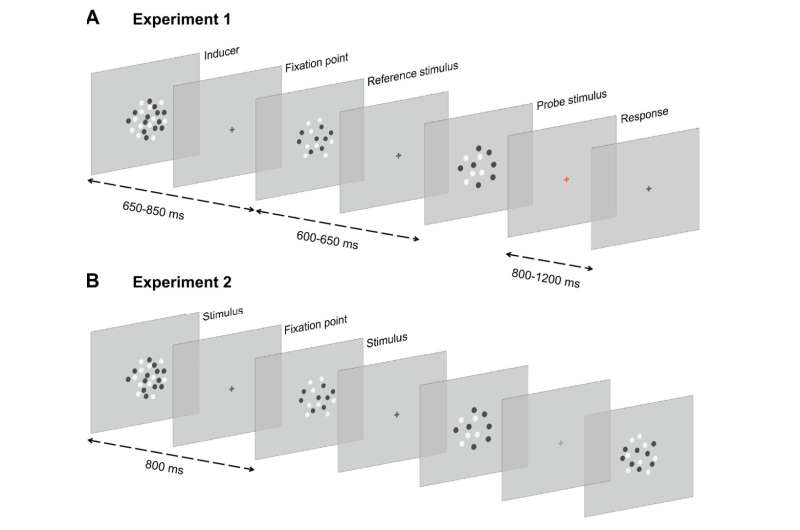‘What we see seems like what we have just seen’: A new study describes the potential origin of this perceptual bias

Things are not always as they appear: what we see seems like what we have just seen, a new SISSA study says. For example, compared to the actual size, an object might seem bigger if it is preceded by the presentation of a big object, and smaller if preceded by a small one. This visual perceptual bias is thus associated with early visual-evoked brain activity and is driven by a trace of past information kept by neural populations at the very basic levels of visual analysis in the brain.
The result of what we see, in short, is a kind of average that the brain makes between what is happening in front of our eyes and what has already happened.
This is the evidence that has emerged from research just published in the Journal of Neuroscience. The new investigation confirms an intriguing scientific issue already explored by neuroscience: what we perceive is often not a faithful representation of what reaches our senses, but a distorted representation of the external world.
According to research authors, Michele Fornaciai, Irene Togoli and Domenica Bueti from Scuola internazionale Superiore di Studi Avanzati (SISSA), this phenomenon is due to the discrepancy between the limited brain computational resources and the plethora of stimuli bombarding our senses. This “bias” reflect the brain’s need to find regularities in the external world, making it more predictable and easier to deal with.
The distortions of reality
“One perceptual distortion consists in seeing similarities between stimuli that are presented in temporal succession,” Michele Fornaciai, first author of the research, explains. “For example, we misjudge the numerosity of a group of objects based on the number of objects we have seen previously.”
Neuroscientists are still trying to understand the neural mechanism underlying this perceptual bias since, as Fornaciai says, “it is unclear whether this bias arises during the processing of visual information leading to perception, or later, at a more cognitive stage, where for example memories are formed.”
“To study this phenomenon,” Fornaciai explains, “we asked a group of volunteers to watch a sequence of very brief sets of objects—simple groups of black and white dots—on a computer screen. Participants judged different aspects of these objects: how many they were, how big they were, and for how long they were displayed on screen.”
“What we measured was the accuracy with which an image was perceived depending on the preceding image. We also measured brain activity via electroencephalography, which allowed us to detect, with millisecond precision, the electrical activity of neuronal populations in the cerebral cortex.”
What the scientists observed is that the participants’ perception was indeed distorted by past images. The research authors confirm, “A group of objects was judged, for instance, larger or more numerous than it was in reality depending on whether the participant previously saw a large or a more numerous sets of items.”
Importantly, “the EEG signals revealed that neurons in the visual part of the brain—the ‘occipital’ cortex—kept a trace of the past visual images. And the greater this trace in brain activity was, the stronger the perceptual bias measured in participants.”
These results thus revealed an important aspect of the perceptual history bias: this illusory percept is generated by visual neurons combining the present sensory information with a trace of past information, something similar to making an average of the previous and the current image. According to these results, this process takes place at the very basic stages of visual analysis in the brain, where the image starts to take form in our mind.
This research also tells us something more about how our brain works. Domenica Bueti, last author of the research, explains, “We often think that our brain works mirroring reality, but this is not true: on the contrary, it ‘builds’ reality, it is a creator of reality. This is because it receives too many inputs from the external world, and it must find a good method of processing them in an effective way.”
“According to our research, the knowledge of the world influences our perception, from which we can also say that perception is partially based on our expectations. What we have already experienced, in some ways, influences the way we will perceive future events. This is a very stimulating issue, not only a scientific perspective, but also from a philosophical point of view.”
More information:
M. Fornaciai et al, Perceptual history biases are predicted by early visual-evoked activity, Journal of Neuroscience (2023). DOI: 10.1523/JNEUROSCI.1451-22.2023
Journal information:
Journal of Neuroscience
Source: Read Full Article
